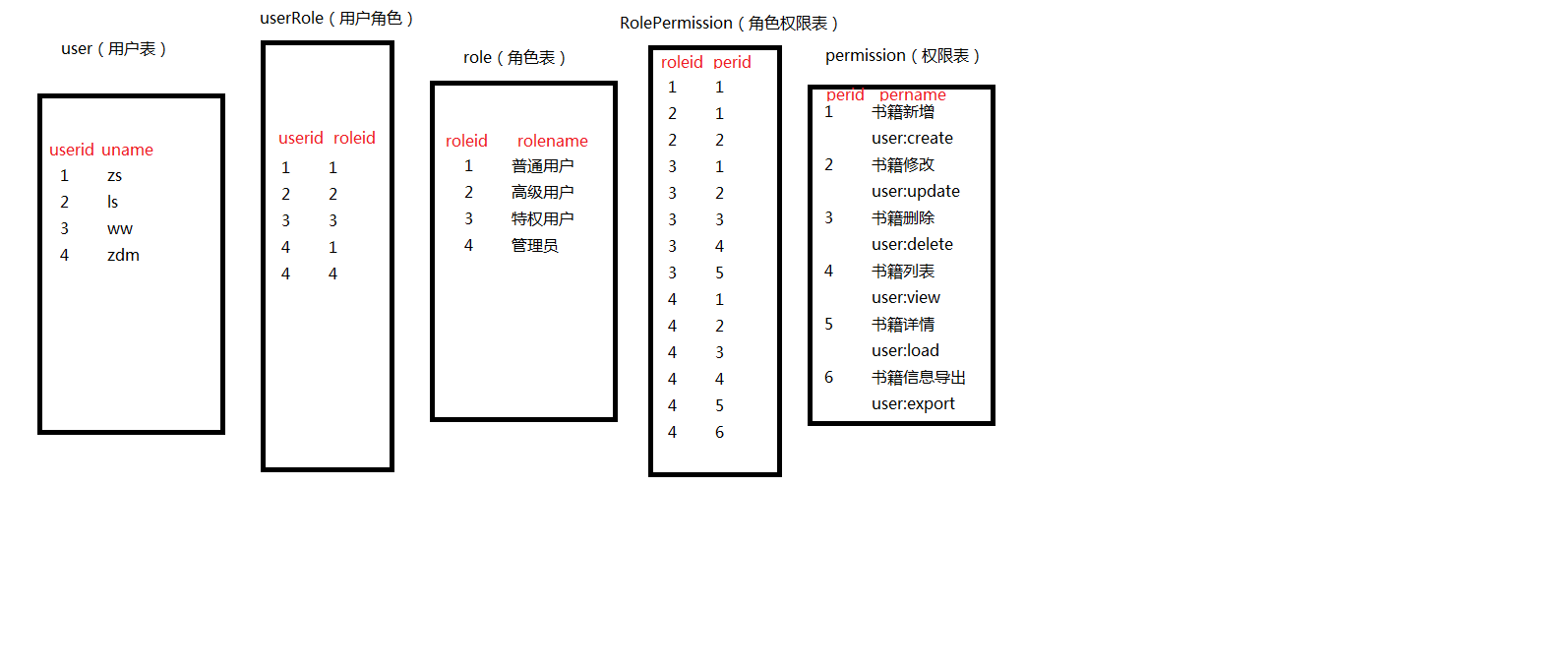一、shiro授权角色、权限
shiro权限设计表:

Service
/**
* 根据用户id查询角色(用于角色验证)
* @param uid
* @return
*/
Set<String> getRolesByUserId(Integer uid);
/**
* 根据用户id查询权限(用于权限判断)
* @param uid
* @return
*/
Set<String> getPersByUserId(Integer uid);
ShiroUserMapper.xml
<select id="getRolesByUserId" resultType="java.lang.String" parameterType="java.lang.Integer">
select r.roleid from t_shiro_user u,t_shiro_user_role ur,t_shiro_role r
where u.userid = ur.userid and ur.roleid = r.roleid
and u.userid = #{uid}
</select>
<select id="getPersByUserId" resultType="java.lang.String" parameterType="java.lang.Integer">
select p.permission from t_shiro_user u,t_shiro_user_role ur,t_shiro_role_permission rp,t_shiro_permission p
where u.userid = ur.userid and ur.roleid = rp.roleid and rp.perid = p.perid
and u.userid = #{uid}
</select>
重写MyRealm中的授权方法
/**
* 授权
* @param principals
* @return
*/
@Override
protected AuthorizationInfo doGetAuthorizationInfo(PrincipalCollection principals) {
ShiroUser shiroUser = this.shiroUserService.queryByName(principals.getPrimaryPrincipal().toString());
Set<String> roleids = this.shiroUserService.getRolesByUserId(shiroUser.getUserid());
Set<String> perIds = this.shiroUserService.getPersByUserId(shiroUser.getUserid());
SimpleAuthorizationInfo info =new SimpleAuthorizationInfo();
info.setRoles(roleids);
info.setStringPermissions(perIds);
return info;
}
二、Shiro的注解式开发
常用注解介绍
@RequiresAuthenthentication:表示当前Subject已经通过login进行身份验证;即 Subject.isAuthenticated()返回 true
@RequiresUser:表示当前Subject已经身份验证或者通过记住我登录的
@RequiresGuest:表示当前Subject没有身份验证或者通过记住我登录过,即是游客身份
@RequiresRoles(value = {"admin","user"},logical = Logical.AND):表示当前Subject需要角色admin和user
@RequiresPermissions(value = {"user:delete","user:b"},logical = Logical.OR):表示当前Subject需要权限user:delete或者user:b
注解的使用
ShrioUserController
/**
* 身份认证的注解
* @param shiroUser
* @param req
* @param resp
* @return
*/
@RequestMapping("/passUser")
public String passUser(ShiroUser shiroUser, HttpServletRequest req, HttpServletResponse resp) {
return "admin/addUser";
}
/**
* 角色认证的注解
* @param shiroUser
* @param req
* @param resp
*
* 当前方法必须同时具备1、4的角色id,才能被访问
* @return
*/
@RequiresRoles(value = {"1","4"},logical = Logical.AND)
@RequestMapping("/passRoles")
public String passRoles(ShiroUser shiroUser, HttpServletRequest req, HttpServletResponse resp) {
return "admin/listUser";
}
/**
* 权限认证的注解
* @param shiroUser
* @param req
* @param resp
* @return
*/
@RequiresPermissions(value = {"user:update","user:view"},logical = Logical.OR)
@RequestMapping("/passPer")
public String passPer(ShiroUser shiroUser, HttpServletRequest req, HttpServletResponse resp) {
return "admin/resetPwd";
}
/**
* 如果身份、角色、权限认证失败后的处理方式
* @param shiroUser
* @param req
* @param resp
* @return
*/
@RequestMapping("/unauthorized")
public String unauthorized(ShiroUser shiroUser, HttpServletRequest req, HttpServletResponse resp) {
System.out.println("错误认证处理方案");
return "login";
}
在Springmvc-servlet.xml中添加
<bean class="org.springframework.aop.framework.autoproxy.DefaultAdvisorAutoProxyCreator"
depends-on="lifecycleBeanPostProcessor">
<property name="proxyTargetClass" value="true"></property>
</bean>
<bean class="org.apache.shiro.spring.security.interceptor.AuthorizationAttributeSourceAdvisor">
<property name="securityManager" ref="securityManager"/>
</bean>
<bean id="exceptionResolver" class="org.springframework.web.servlet.handler.SimpleMappingExceptionResolver">
<property name="exceptionMappings">
<props>
<prop key="org.apache.shiro.authz.UnauthorizedException">
unauthorized
</prop>
</props>
</property>
<property name="defaultErrorView" value="unauthorized"/>
</bean>
main.jsp
<ul>
shiro注解
<li>
<a href="${pageContext.request.contextPath}/passUser">身份认证</a>
</li>
<li>
<a href="${pageContext.request.contextPath}/passRoles">角色认证</a>
</li>
<li>
<a href="${pageContext.request.contextPath}/passPer">权限认证</a>
</li>
</ul>